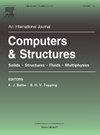A review on the applications of artificial neural network techniques for accelerating finite element analysis in the civil engineering domain
IF 4.8
2区 工程技术
Q1 COMPUTER SCIENCE, INTERDISCIPLINARY APPLICATIONS
引用次数: 0
Abstract
Finite element (FE) modelling is widely recognised as the most powerful and foremost computational technique for analysing complex structural systems due to its highly efficient modelling and simulation capabilities. Despite the strengths, its computational demands restrict its ability of performing instantaneous computations and present substantial challenges for achieving real-time analyses results. However, the integration of artificial neural networks (ANNs) with FE modelling offers a simplified calculation process whilst accelerating the computational time substantially. In this light, current study conducts a worth and timely investigation on application of ANNs as a surrogate for real-time FE modelling in the civil engineering domain. ANNs can be integrated into the computational process of FE modelling in numerous ways and selecting the type of the neural network architecture for surrogate modelling and integrating it to represent the FE model are crucial. Even though that depends on the complexity of the model that is to be analysed, the graph neural networks (GNNs) showed an excellent performance in both analysing and visualising mesh-based FE modelling as it incorporates the underlying relationship among different elements in a FE mesh. ANNs have the potential to significantly accelerate forward calculation process and also, provide a more efficient approach to inverse analysis. However, such applications are seldom in the existing body of knowledge. It has been identified that predicting stress or displacements was the most common primary goal of most studies with a particular emphasis on addressing static structural behaviour.
人工神经网络技术在土木工程领域加速有限元分析中的应用综述
有限元(FE)建模由于其高效的建模和仿真能力而被广泛认为是分析复杂结构系统最强大和最重要的计算技术。尽管有这些优势,但其计算需求限制了其执行瞬时计算的能力,并对实现实时分析结果提出了实质性的挑战。然而,人工神经网络(ann)与有限元建模的集成提供了一个简化的计算过程,同时大大加快了计算时间。因此,本研究对人工神经网络在土木工程领域实时有限元建模中的应用进行了有价值且及时的研究。人工神经网络可以通过多种方式集成到有限元建模的计算过程中,选择用于代理建模的神经网络架构类型并将其集成到有限元模型中是至关重要的。尽管这取决于要分析的模型的复杂性,但图神经网络(gnn)在分析和可视化基于网格的有限元建模方面表现出色,因为它将有限元网格中不同元素之间的潜在关系结合在一起。人工神经网络具有显著加速正演计算过程的潜力,同时也提供了一种更有效的逆分析方法。然而,这样的应用很少在现有的知识体系中。已经确定,预测应力或位移是大多数研究中最常见的主要目标,特别强调解决静态结构行为。
本文章由计算机程序翻译,如有差异,请以英文原文为准。
求助全文
约1分钟内获得全文
求助全文
来源期刊

Computers & Structures
工程技术-工程:土木
CiteScore
8.80
自引率
6.40%
发文量
122
审稿时长
33 days
期刊介绍:
Computers & Structures publishes advances in the development and use of computational methods for the solution of problems in engineering and the sciences. The range of appropriate contributions is wide, and includes papers on establishing appropriate mathematical models and their numerical solution in all areas of mechanics. The journal also includes articles that present a substantial review of a field in the topics of the journal.
 求助内容:
求助内容: 应助结果提醒方式:
应助结果提醒方式:


